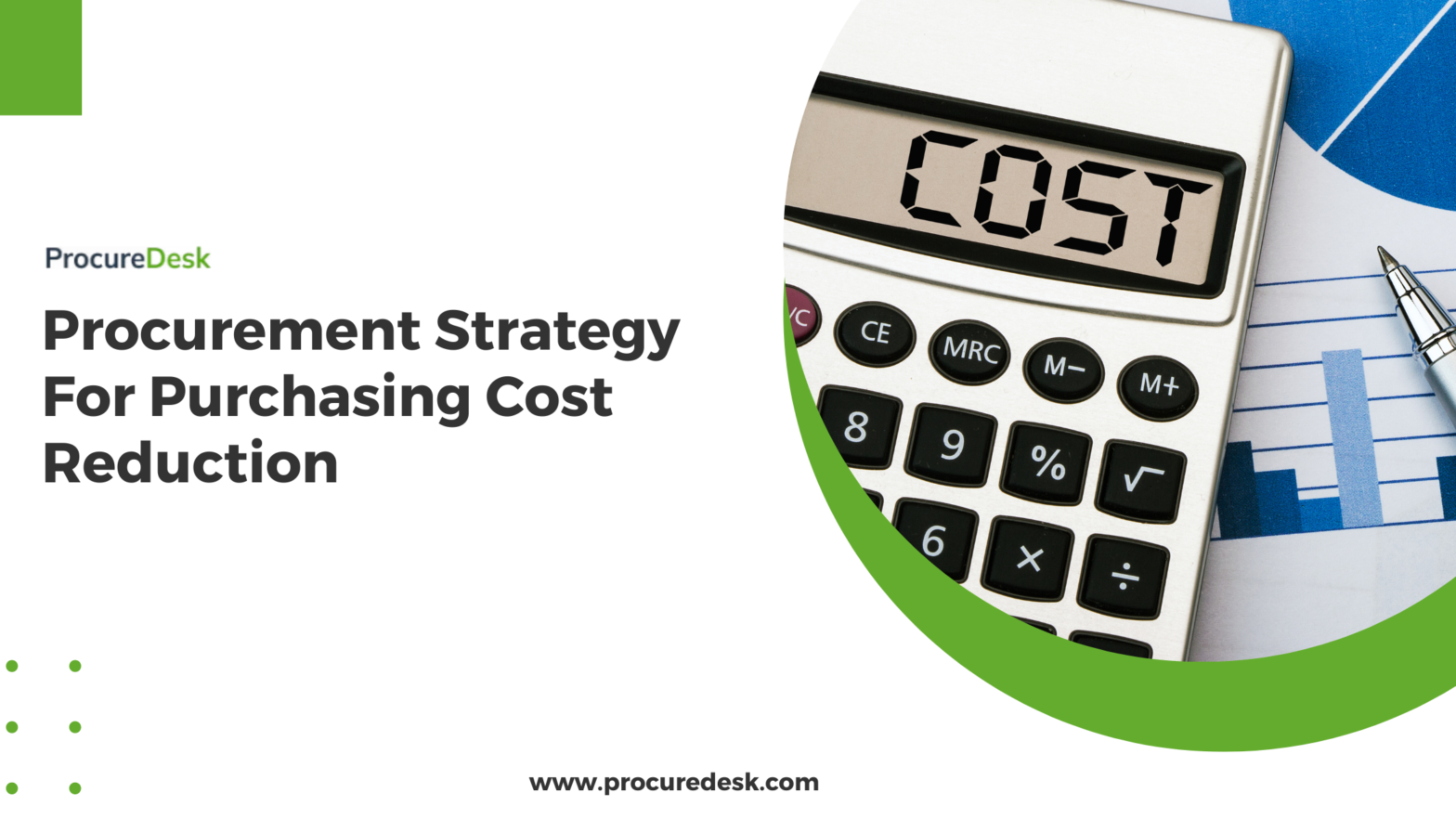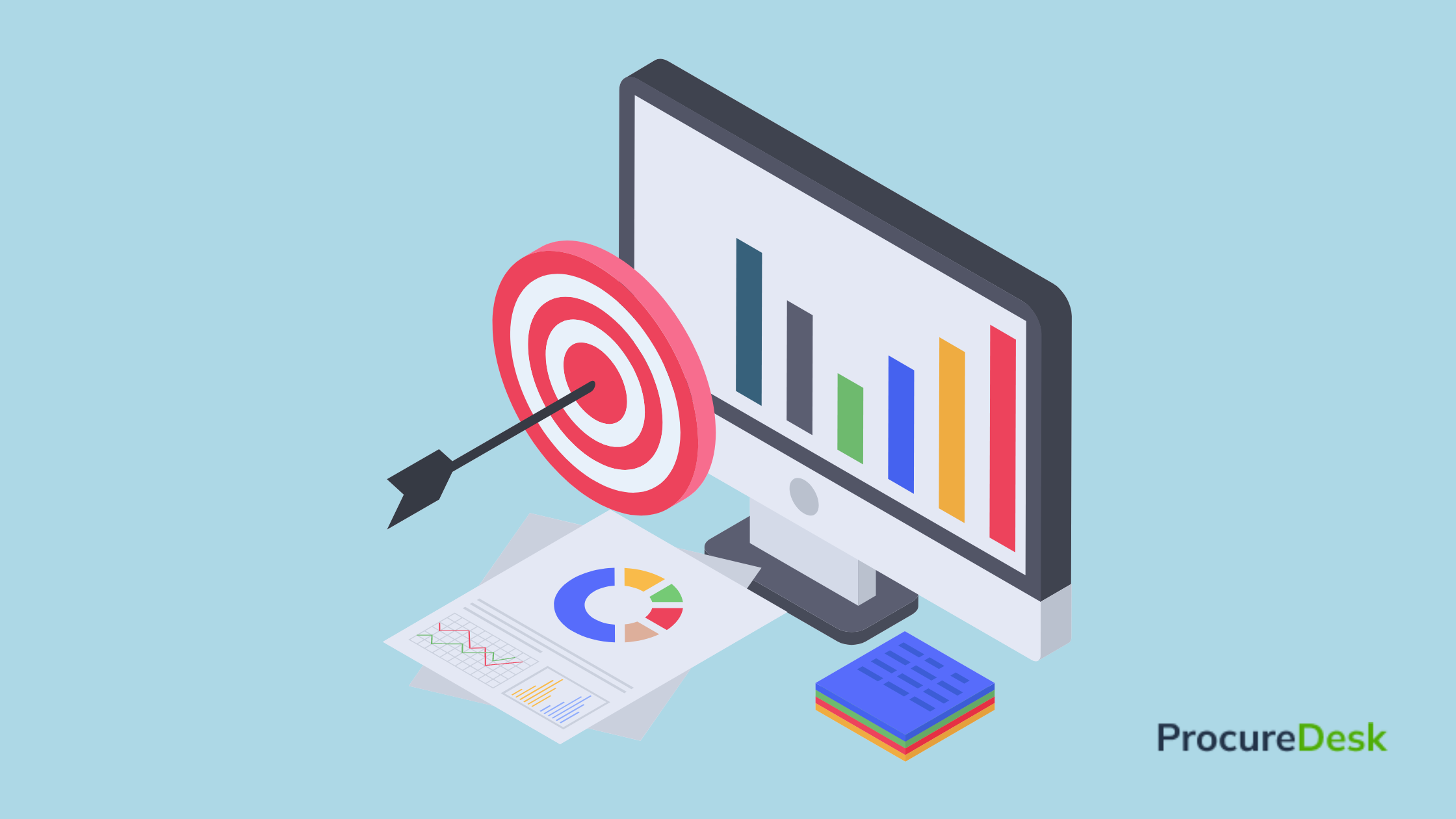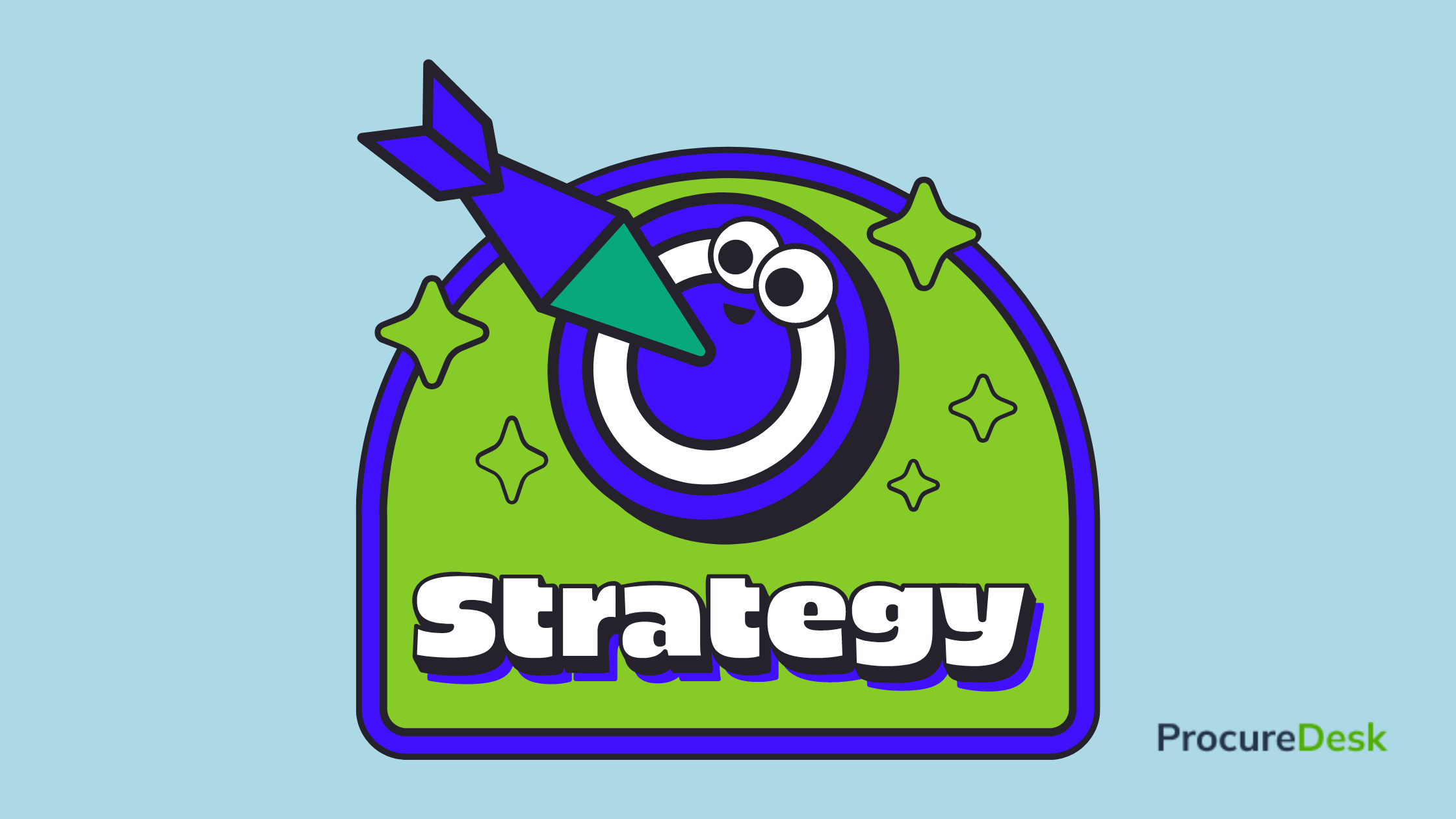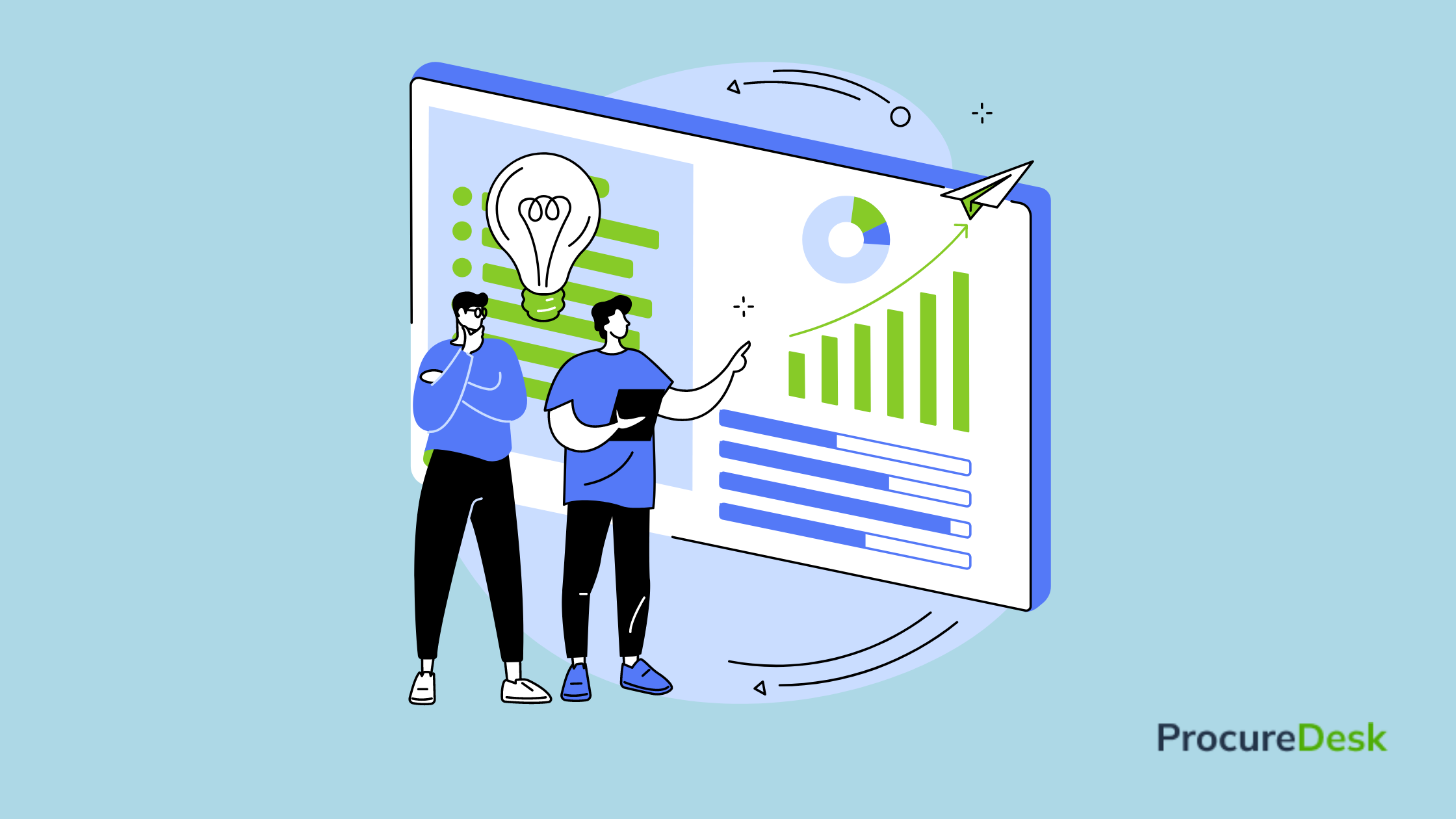Procurement strategy is an essential component of effective procurement for all companies, regardless of size.
Procurement teams at large companies rely on effective procurement strategies to deliver continuous savings, which increase a company’s EBITDA (Earnings before Interest, Tax, Depreciation, and Amortization). It is common for companies to see cost savings of up to 10% of the annual addressable spend because of an effective procurement strategy.
Executing a well-defined procurement strategy needs discipline and resources, and that might deter some mid-market companies from having a procurement strategy in the first place. Mid-market companies should not ignore the value of a well-defined procurement strategy. This article is focused on helping mid-market companies get started on a path of procurement excellence through effective procurement strategy and preventing maverick spending.
What Is A Procurement Strategy?
A procurement strategy is about procurement, so let’s first define procurement. As per CIPS (Chartered Institute of Procurement & Supply) – “Procurement is the business management function that ensures identification, sourcing, access, and management of the external resources that an organization needs or may need to fulfill its strategic objectives.”
Simply defined, it is a process of acquiring product or services a business need to deliver value to its customers. Value is defined in terms of physical products or services delivered to customers.
Steps In The Procurement Process
There are multiple steps in the procurement process. The basic steps are listed below
Step 1: Need Determination
The first step in procurement is determining the following:
- What needs to be purchased?
- What should we do to implement cost-cutting measures?
- How do we boost our capital budget?
- How do we optimize our annual budget efficiently?
The need could be new or recurring—for example, raw materials required to manufacture the products sold by an organization.
A non-routine activity could determine the need. For example – the purchase of new procurement software.
Starting with this step will help your finance team make better procurement decisions and prevent exerting effort into low-value activities.
Step 2: Specification Definition
This step is generally required for new purchases – products that are not purchased earlier. For example, the company has decided to add a new product to the product line that fits the company’s product quality.
This drives detailed discussion and collaboration between departments to develop the optimum specification. If you over-engineer the specifications, that limits the source of supply and increases cost.
If you keep the specifications simple, the results are reduced cost and increased availability from different suppliers.
Step 3: Sources Of Supply
The next step in procurement is to make an assessment of your sources of supply. Will you evaluate the previous performance of suppliers? Or are you going to scout new vendors?
Do you need a new supplier for this purchase, or an existing supplier can fulfill the requirement?
Depending upon the product type, this could be a simple Google search or elaborate research leading to RFP. If you are adopting a low-cost country sourcing strategy, the step needs a detailed assessment.
Step 4: Supplier Selection
The supplier selection process encompasses choosing the appropriate vendor and, if necessary, managing contracts. This crucial step typically involves initiating an RFP (Request for Proposal) process, followed by careful contract negotiations and subsequent execution to ensure compliance with the agreed-upon terms.
Considerations such as supplier, supply, and transport costs are considered throughout the procurement process. Additionally, volume discounts and establishing long-term relationships are factors considered during supplier selection to optimize the procurement strategy.
Step 5: Purchasing Activity
This encompasses the necessary steps involved in acquiring materials.
The process typically begins with obtaining approval, followed by issuing a purchase order to the supplier, and may also include any necessary follow-up communication with the vendor.
Managing the volume of purchases is an important consideration during this activity to avoid excess inventory and address any inefficiencies in the procurement process.
Cost budgeting is crucial in ensuring that procurement costs align with the allocated budget, as managing and controlling these expenses can be a significant challenge.
Leveraging bulk discounts is a strategy that can lead to additional savings, providing an opportunity to optimize costs and enhance overall procurement efficiency.
Step 6: Receipt
The purpose of receipting is to inspect whether the vendor shipped per the purchase order. It is also proof of delivery, as stated in the delivery terms while approving the invoice.
Step 7: Payment
The payment process is the issuance of payment to the vendor. Multiple payment terms and payment vehicles are available to companies—for example, ACH process, Checks, or purchasing cards.
Step 8: Supplier Management
Supplier management is a crucial but often overlooked aspect of your company’s procurement performance. It holds particular significance in strategic partnerships with vendors, as effectively managing supplier performance and cultivating strong relationships can result in streamlined operations and cost savings for buyers and suppliers.
This entails overseeing and optimizing contract terms and identifying and implementing various cost savings throughout the procurement. Additionally, ensuring a well-defined approval process helps maintain control and consistency in supplier engagements. Businesses can better manage procurement activity and mitigate unnecessary expenses by actively monitoring inventory levels and addressing rogue spending.
Moreover, supplier management involves negotiating competitive purchase prices and making informed decisions based on market insights and trends. Leveraging the expertise of third-party providers or external partners can also enhance supplier management efforts, enabling access to specialized resources and industry knowledge. Ultimately, dedicating attention to effective supplier management can significantly contribute to the success of your company’s procurement endeavors.
What Are The Benefits Of A Procurement Strategy?
The obvious question is why define a procurement strategy. Most mid-market companies don’t have dedicated procurement departments, so why define a procurement strategy? Let’s look at some of the benefits of having a procurement strategy
Corporate Strategy And Procurement Strategy Alignment
The biggest benefit of having a procurement strategy is aligning the corporate goals and how procurement helps achieve those goals.
Let’s assume that your organization’s competitive advantage is to offer custom products in the shortest lead time across the industry. Aligning your procurement strategy with the organization’s competitive advantage will help determine the right partners who can help you deliver products faster and at the desired quality levels. Aside from that, it will help you understand how to manage your costs in procurement more effectively.
For example, you are probably the Walmart of your industry. In that case, your procurement strategy should be aligned with the corporate goal of being a low-cost solution provider. A well-defined procurement strategy would help identify partners aligned with this goal.
Measurable Outcome
A well-defined procurement strategy provides a mechanism to measure the impact of effective procurement on meeting organizational goals.
For example, assume the company aims to reduce cost and improve EBITDA (Earnings before Interest, Tax, Depreciation, and Amortization). The procurement strategy is then focused on reducing overall cost, and the outcome is measured in terms of the dollars saved and the impact on the bottom line.
Since the outcome is measurable, it helps bridge the expectations gap between procurement and senior management of the company.
Standard Operation Procedures
A procurement strategy brings clarity and provides guidelines on purchasing in any company.
For example – if the outcome of your procurement strategy is that you are adopting a low-cost country sourcing, then the approach for vendor selection doesn’t need to be discussed for every sourcing event.
It also provides guidelines for other employees on how to engage in procurement, which in turn helps achieve overall procurement goals.
Cost-Reduction Opportunities
A robust procurement strategy provides a framework for identifying and capitalizing on cost-reduction opportunities. It allows businesses to optimize their purchasing power, negotiate better deals, and implement cost-reduction measures effectively, leading to significant savings in procurement.
Mitigating The Risk of Disputes
A carefully crafted procurement strategy includes clear contractual terms and guidelines, reducing the risk of disputes with suppliers. It ensures all parties have a shared understanding of expectations, minimizing potential conflicts or legal issues.
Reducing Administrative Costs
A well-defined procurement strategy helps reduce administrative costs associated with procurement activities. Businesses can minimize administrative overheads and allocate a broader range of resources more efficiently by centralizing procurement operations, standardizing processes, and leveraging technology solutions.
Better Company Savings With Centralized Procurement
Ultimately, one of the primary benefits of a robust and centralized procurement strategy is the realization of savings. Organizations can achieve substantial savings in their procurement activities by optimizing procurement processes, leveraging purchasing power, and driving cost-reduction initiatives, positively impacting the bottom line.
What Are The Components Of A Procurement Strategy?
Having defined procurement strategy and its potential benefits, let’s look at how to define the procurement strategy and the key components of an effective strategy.
Like any other strategy, procurement strategy starts with a goal in mind. Generally, most procurement organizations are tasked with one or more of the following goals
First and foremost, design a procurement strategy to support the needs of the business. For example – a credit card company wants local call centers to support the customers. The goal itself will drive the locations of the call centers. The procurement strategy is very different in this case as compared to outsourcing call centers to low-cost countries.
1. Procurement should be done effectively: Hence the second goal is to reduce procurement and overhead costs for direct and indirect materials. Direct materials are raw materials used in products, and Indirect materials are products & services required to support the operations.
2. Increase compliance with corporate policies: This is especially critical for public companies because a well-defined purchasing process would simplify SOX (Sarbanes Oxley) reporting requirements.
3. Reduce supply chain risk through Supply Chain Management: Depending upon the size and type of the business, this might or might not be a priority for the business. For example, a manufacturing company wants to ensure that raw materials are available at the right time and quality. The procurement strategy should be designed to reduce supply chain risk. There are different types of supply chain risk. Some of them are – the risk of delivery costs, quality, reputation, and natural disasters risk.
So, before you move any further, define the key goals you want to achieve and then start defining the procurement strategy. For example, reducing annual purchasing costs by 10% is a good example of a goal. Your goal should be SMART (Specific, Measurable, Actionable, Relevant, and Time-Bound)
Once you have defined the goals for the procurement strategy, it is time to start working on the design of the procurement strategy. The process can be broken down into the following steps
What Should You Evaluate In Your Procurement Process?
This is a no-brainer that you need to evaluate your current processes and how they currently support the goals of the procurement strategy. You should at least evaluate the following
Procurement Policy
This step covers how you currently source the product and services and where your key suppliers are located. The goal is to determine whether your supplier base is local, national, or International. This will help you identify levers you can use in the procurement policy. For example – if most of your purchasing is done locally, does it make sense to expand nationally or even adopt a low-cost country sourcing?
Bidding Policy
The bidding policy defines the supplier selection process, which includes competitive bidding. The assessment of the bid policy helps uncover opportunities for further improvement. Key questions to ask during this assessment
- What do we bid today? For example – some companies have policies that they don’t bid anything under $50,000.
- How do you bid? Is the process working?
- Is the process fair and set up in a way that avoids any conflict of interest?
Engagement With Stakeholders
This assessment aims to understand how stakeholders view the procurement function and what they consider as a value-add from such a function. You must have buy-in from key stakeholders on the expected value-add of the procurement function. If you don’t have an existing procurement function, it is still a good idea to assess if having such a function would add value and help meet company goals.
Tools Assessment
A procurement toolkit might not be the first thing that comes to mind while designing a procurement strategy, but it should be an important component of your strategy. Things to assess
- What systems do we use today to purchase products or services?
- Can all employees use that tool to enter purchase orders, or must they send paper requisitions to a single person?
- Do you have a way to ensure that spend is consolidated with your preferred vendors?
- Do you have tools to execute sourcing events like RFP (Request for Proposal) or e-auctions?
Skill Assessment
The last step in the assessment process is to assess whether your existing procurement team has the skill sets to execute the procurement strategy. For example, Your strategy is to adopt a low-cost country sourcing strategy for cost reduction. So, do you have any team members with experience in low-cost country sourcing?
Procurement Strategy Design And Execution
The next step towards defining the procurement strategy is designing the procurement strategy and ensuring that you have the right internal resources to execute the strategies. Let’s assume that one of the goals of your procurement strategy is to reduce the purchasing cost by 10%. So, some of the common outcomes of this step are as follows
Supplier Strategy
The supplier strategy would guide the partners you work with to reduce costs and improve supplier relationships. This might include the following scenarios
1. Single source supplier strategy, where you purchase products and services from only one supplier. This not only helps bring opportunities for cost reduction but also helps keep a close eye on their performance. The single-source supplier strategy has its drawbacks, too; it increases supply chain risk. To mitigate that, you must implement processes to track how your company handles risk management.
2. We must consolidate current suppliers to route spend to the top 2 vendors. If you are a multi-location company, you must buy-in from all stakeholders and locations.
3. We need to source from low-cost countries because the vendor consolidation efforts will not be able to drive the cost down enough for savings opportunities.
Bidding Strategy
The bidding strategy will provide guidelines on how you would use competitive bidding to meet the goals of your procurement strategy. Some of the common outcomes of this strategy are
- The bidding would be done for all purchases greater than $50,000. Anything under that can be purchased without a formal bidding process.
- A formal bidding process would include a 3-bid and buy process. All bids exceeding the defined threshold would require proposals from three vendors.
Procurement Tools Strategy
The key component of the execution of procurement strategy is the tool sets that would help in execution. Some expected outcomes from this step are as follows
- Tools for automating the purchase order process and ensuring that negotiated product/service rates are used across the company.
- Tools to ensure the bidding process can be automated and scaled up as required.
Best Practices Of A Procurement Strategy
We close this topic with some best practices you should follow while implementing a procurement strategy.
Involve Key Stakeholders
Procurement strategy can’t and shouldn’t be defined in isolation. The key to success is to have a strategy that is well-adapted and has the buy-in from key stakeholders.
Designing a strategy without consensus and hence no adoption is not good. For example, you might conclude that vendor consolidation is the right procurement strategy, but the operations head might disagree because that increases the supply chain risk. So, an effective strategy is first to get feedback on the proposed strategy and address any concerns they might have. In the end, the strategy should be quantified into cost savings so that you can evaluate the true effect of the strategy.
If you don’t have a procurement team today, start with getting feedback from different stakeholders. Then converge the feedback into a coherent procurement strategy that works for most of the executive team. It is difficult to get 100% buy-in.
Keep The Bidding Process Simple
An integral part of the procurement strategy is the bidding process. In other words, a vendor selection process. Having a bidding policy is critical, but ensure that it is practical.
The common advice is to have a five-step or seven-step strategic sourcing process. That is a good practice but might not work for all categories and product or service purchases. The common feedback from stakeholders about the bidding process is that it takes too long to run a sourcing event. Though that is not true in all cases, sometimes the RFP process can drag on and extend the vendor selection process.
The key is to hear feedback from your stakeholders and optimize the bidding process to adapt to your stakeholders’ unique needs.
Transparency And Reporting
Ensure that you provide complete transparency into the results of the procurement strategy. It is critical to support the claims of successful strategy implementation with detailed reporting at each department level. This will help ensure that your company avoids any unnecessary spending.
For example, if the key goal of the strategy is to reduce cost, you should report overall achievement to senior management every quarter. For individual department owners, the reporting should be done every month on how they are doing against their allocated budget and how procurement is helping them to reduce the overall cost.
Though savings is an important part of the equation, the focus should not solely be on procurement savings. You should evaluate the reporting needs of your stakeholders and accordingly support the reporting requirements. For example, procurement can help stakeholders with the forecast of expenses and avoid any surprises.
Continuous Improvement
No plans survive the reality test, no matter how well planned. A procurement strategy is no different. Plan for revising procurement strategy based on feedback from stakeholders.
Try to get regular feedback. The best way to get feedback is to have a quarterly review meeting with each key stakeholder. Ask interrogative questions, for example – What do you think about the effectiveness of the procurement strategy and how we can further improve it?
Don’t ask how we are doing because you will not get negative feedback.
Conclusion
No doubt that implementing a well-developed procurement strategy offers numerous advantages, including cost reduction opportunities, reduced costly errors, mitigated the risk of disputes, improved performance evaluation, streamlined operations, reduced administrative costs, ensured the success of cost reduction efforts, informed corporate-level decision-making, centralized procurement benefits, and tangible savings in procurement.
Whether you are a Fortune 500 company or a growing mid-market company, it is critical to review your purchasing policies and ensure opportunities for reduction in procurement as much as possible to save your company from costs.
Document the desired goals and then design a procurement strategy to meet those goals.
We hope you found this article helpful. Read more on procurement in mid-market.
It’s about time to create a successful cost-reduction strategy for your organization!
If you’re interested in exploring procurement options for your company, schedule a demo with our team and understand what it takes to be a procurement professional with the right software!















